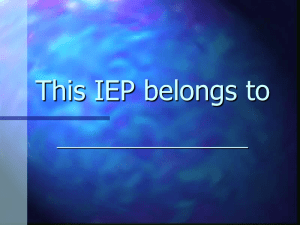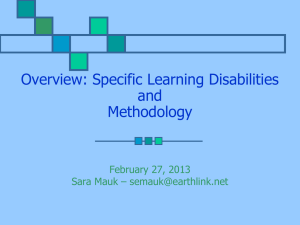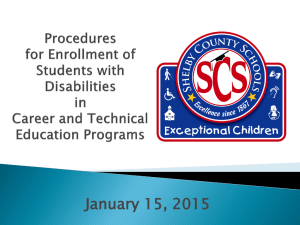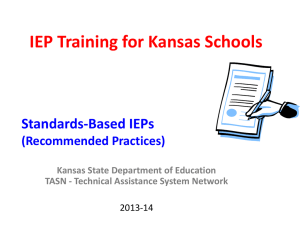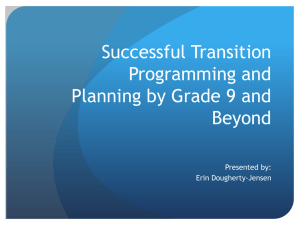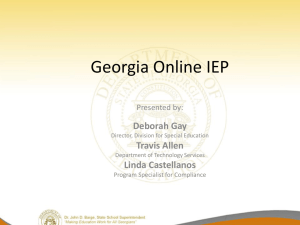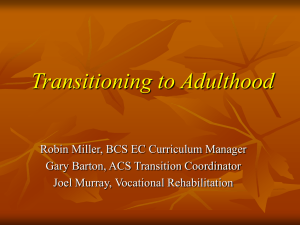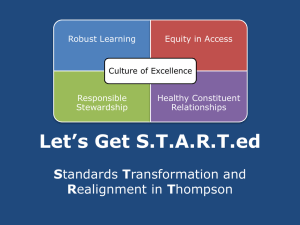Standards Based IEP Training - Alexandria, Minnesota School
advertisement
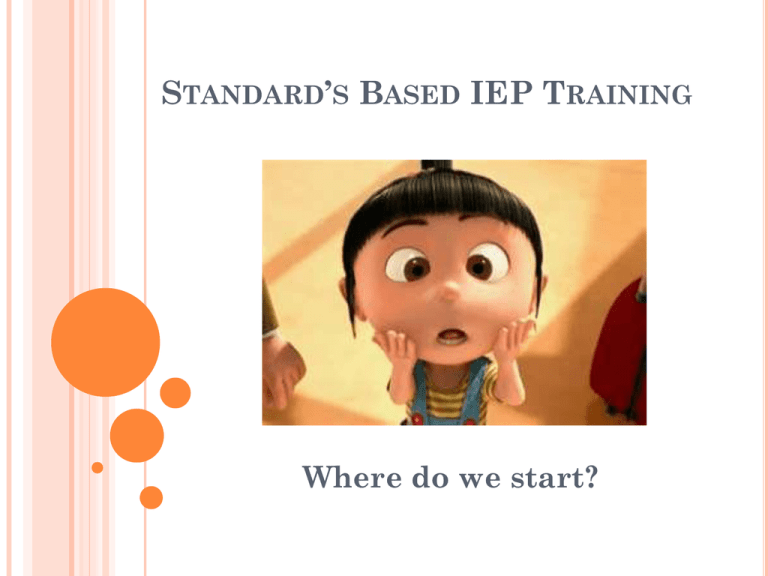
STANDARD’S BASED IEP TRAINING Where do we start? STANDARDS-BASED IEP’S Beginning with the reauthorization of IDEA in 1997, significant federal legislation was passed that dramatically changed how states and local school districts function. Accountability for student learning became foremost in federal regulations. Let’s briefly review the legislation that impacted our state’s policies and school district practices STANDARDS- BASED REFORM IDEA reauthorization 1997 Access to, participation and progress in the general education curriculum. No Child Left Behind Act of 2001 Aligned system of standards and assessments; Accountability for ALL students. State and local Adequate Yearly Progress (AYP) IDEA 2004 and 2007 reauthorization STANDARDS-BASED REFORM In the past 10 years, Federal legislation has focused on two major assumptions related to teaching and learning: 1). Special education students have the right to be taught as if they can meet the same high standards expected of all students. 2). All students must be provided with opportunities to learn the general education curriculum. STANDARDS-BASED REFORM A few challenges along the way: It changes the way special education staff think about instruction for students with disabilities. It raises the expectations for all student learning. It requires by law that all children have access to grade- level content (math and language arts) state identified standards. Staff must now plan, teach, and assess students on a more frequent basis so that the student can participate and make progress in the GENERAL EDUCATION curriculum. WHAT DOES “ACCESS TO” GRADE-LEVEL CONTENT STANDARD’S MEAN? Access means that all student have opportunities to participate in the knowledge and skills that make up the general education curriculum. Free and Appropriate Education (FAPE) is defined in the 2006 IEA regulations at 34 CFR 300.17 to mean: Special Education and related services that(a) are provided at public expense, under public supervision and direction, and without charge, (b) Meet the standards of the State Educational agency (Minnesota Department of Education) (c) Include an appropriate preschool, elementary school, or secondary school education in Minnesota, and (d) Are provided in conformity with an IEP that meets the requirements of 34 CFR 300.320 through 300.324. THE DESTINATION AND THE “FLIGHT PLAN” The Destination: Standards-based instruction is a process for teaching all students clearly defined content standards for the purpose of improving academic performance (Destination). The Flight Plan: The goal then is for general education teachers, learning specialist and administration to form a collaborative partnership so that the development and implementation of standard’s based instruction will be guided by a standard’s based Individual Education Program (IEP) “flight” plan. DEVELOPING STANDARD’S BASED IEP’S The Individual Education Program (IEP) plan is the cornerstone of access to the general education curriculum. Basing the student’s IEP on grade-level content standards: Provides opportunities to learn the same content learned by non-disabled peers. Addresses the unique needs presented by the student’s disability Emphasizes access through analysis of the student’s disability and how it will impact learning. WHAT STEPS DO IEP TEAMS NEED TO FOLLOW TO DEVELOP EFFECTIVE STANDARDS-BASED IEP’S? Step 1: Collect and examine materials for making data-based IEP decisions. Review information from: Courses of study and/or curriculum guides Current MCA, DALT and Classroom/Grade Level assessment results Student work samples Previous year’s IEP Grades Discipline referrals Attendance reports WHAT STEPS DO IEP TEAMS NEED TO FOLLOW TO DEVELOP EFFECTIVE STANDARDS-BASED IEP’S? Step 2: Analyze data to develop the student profile. The profile should include general statements regarding : Strengths Needs How the disability affects involvement/progress in the general education curriculum Assessment/Evaluation Status of Prior IEP goals Teacher/Parent/Student/input Transition needs ( by grade 9) WHAT STEPS DO IEP TEAMS NEED TO FOLLOW TO DEVELOP EFFECTIVE STANDARDS-BASED IEP’S? Step 3: Use date to summarize the Present Level of Academic Achievement and Functional Performance (PLAAFP). Characteristics: It needs to be standard’s centered Data Driven Understandable Measureable WHAT STEPS DO IEP TEAMS NEED TO FOLLOW TO DEVELOP EFFECTIVE STANDARDS-BASED IEP’S? Components of the PLAAFP: Student Strengths: Include information on the student’s response to learning strategies, accommodations, interventions and content standard instruction. Refrain from using the students exceptionality to explain how the disability affects involvement in the general curriculum. Student Needs: Focus on identified needs that affect the progress in the general education curriculum. Ask yourself…. What prerequisite skills/knowledge does the student need to close the gap between his/her present level and the grade level content standards? How the Disability Affects Performance: Consider how the student’s disability affects progress in learning the grade-level content standards. For example: “Emma’s difficulties retrieving information may negatively impact her progress in achieving reading standards that include synonyms, antonyms, and multiple-meaning words”. SAMPLES Present Level of Academic Achievement and Functional Performance Classroom assessments indicate that Ashlee can use details and examples to draw conclusions from grade level reading passages. She experiences difficulty with synthesizing ideas from reading passages and drawing inferences as indicated on the most recent Minnesota Comprehensive Assessment. Ashley’s difficulty with abstract reasoning may negatively impact her understanding and drawing inferences from text. Marcus’ weakness in applying strategies, such as making inferences and making complex predictions, affect his progress in comprehending sixth-grade literacy materials. WHAT STEPS DO IEP TEAMS NEED TO FOLLOW TO DEVELOP EFFECTIVE STANDARDS-BASED IEP’S? Step 4: Select the Content Standard(s): Consider content area standards Look at all grade-level content standards and “unpack” the standard (break the standard into it’s component parts. Analyze the subskills and determine which are most important for each student (based on progress in the general education curriculum) Compare standard(s) with student’s area of needs and the impact of the disability Use data to determine the areas the student will find difficult without additional supports. WHAT STEPS DO IEP TEAMS NEED TO FOLLOW TO DEVELOP EFFECTIVE STANDARDS-BASED IEP’S? STEP 5: Write the Annual Goal(s) based on Minnesota Standards. Purpose= Describe what a student can reasonably expect to accomplish in one school year. Annual Goals answer the question “What should the student be doing?” Annual goals are related to needs resulting from the student’s disability that directly affect involvement and progress in the general education curriculum. Select the need that has the greatest impact on progress, and develop a goal to address that need. FIVE ESSENTIAL COMPONENTS OF A MEASURABLE ANNUAL GOAL The Student… (WHO) Will do what….. (BEHAVIOR) To what level or degree….. (CRITERION) Under what condition….. (CONDITION) In what length of time…..(TIMEFRAME) EXAMPLES OF MEASUREABLE ANNUAL IEP GOALS “Given high interest reading materials with visual cues, Mara will increase her reading comprehension skills by identifying the main idea in a fourth grade reading passage from one 1 out of 5 times on two consecutive trails to 4 out of 5 times on two consecutive trials by the end of the fourth quarter grading period”. “Jacob will increase his reading fluency skills from 75 words of connected text per minute to 110 words of connected text with 100 % accuracy at the end of 36 weeks”. “ By the end of the third trimester grading period, Angela will use prior knowledge and life experience to make generalizations from her personal experience to answer comprehension questions from grade 7 recreational reading materials with an average of 90 % accuracy on classroom assessments”. DEPARTING THOUGHTS …. “Coming together is a beginning; Learning together is progress; Working together is success.” ~ Henry Ford


